Galaxy S6 and S6 Edge review: Samsung's best phones in years

Samsung found itself in sort of a bind last year: Its flagship Galaxy S5 wasn't the blockbuster the company hoped it would be. That, coupled with the news that Samsung was going to focus on a smaller number of devices in 2015, signaled a pretty dramatic change for a brand that seemed like it was unstoppable. As if to silence the doubters, Samsung has not one, but two flagships on offer -- the Galaxy S6 and S6 Edge -- and they're surrounded by questions. Can they restore Samsung to its former glory? Has the company figured out how to build a truly interesting smartphone again? It's too early to make a call on the former, but after a week of testing, the answer to the latter is a clear and definite "yes."
Hardware
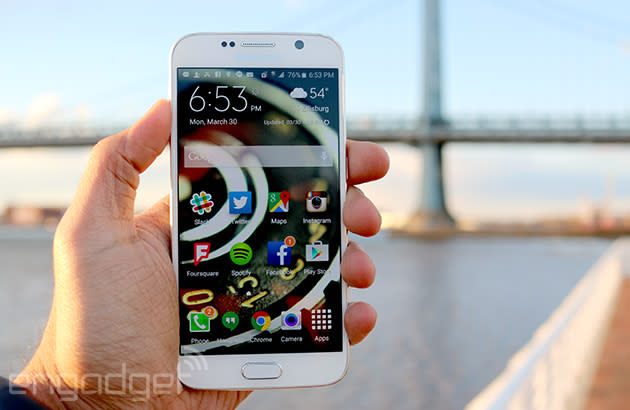
Before we go any further, know this: Aside from the obvious differences -- the Edge has a wrap-around screen and a few software tricks that take advantage of it -- the Galaxy S6 and the S6 Edge are basically identical. Same screen size, same 16-megapixel cameras, same octa-core Exynos 7420 brains, and so on. They're two devices crafted with the same metal, glass and silicon, which makes the dramatic design differences between them all the more meaningful.
Looking at it dead on, though, the S6 is pretty plain. Your eyes will immediately get sucked into the 5.1-inch Quad HD Super AMOLED screen, but a 5-megapixel selfie camera sits above it while the Home button lies below, flanked by discrete Back and Recent Apps keys. High on the S6's back is a squarish plateau that houses the 16-megapixel camera, and to the right lies a tiny black divot where the LED flash and heart rate sensor live. Unlike the crater that marked the Galaxy S5's back, the assembly here is almost flush with the S6's rear. It's a small touch, but it makes taking heart rate and blood oxygen readings in S Health quite a bit easier.
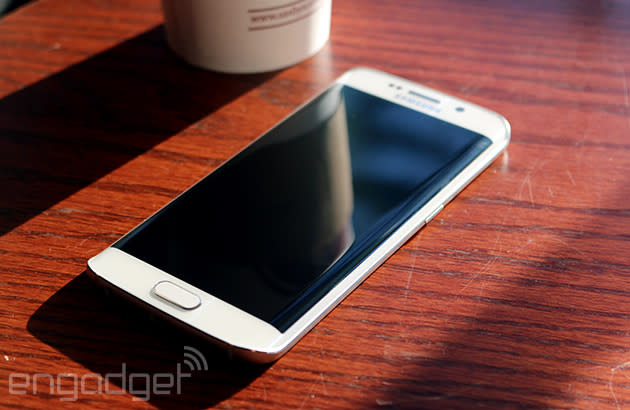
Really, it's details like these that speak most loudly to Samsung's new design philosophy. Let's put aside for a moment the fact that Samsung traded its trademark plastic bodies for sturdy metal frames and Gorilla Glass 4 panels lining the S6's front and back. What's more important -- and consequently harder to express in words -- are the little touches that tie everything together. The S6's rounded sides are punctuated by a flat edge for your fingers to rest on. The gaps between the metal and Gorilla Glass are so fine as to be imperceptible. The sole speaker has been moved to the phone's bottom so you're not blasting tunes straight into your desk. I could go on, but the S6 just feels seamless in a way its predecessor never did.
And no, your eyes don't deceive you: The Galaxy S6 looks (and feels) an awful lot like an iPhone. From those rounded sides to the chrome-rimmed, fingerprint-sensing Home button to placement of the volume buttons on the left edge and the power button on the right, there's an odd air of familiarity surrounding the thing. (A brief aside: One of Samsung's spokespeople picked up my iPhone 6 during our hands-on time in February and it seemed to take him a few moments to realize what he was actually holding.) Flame wars on the matter are already starting to brew, but I'm not too concerned; Samsung's end result is lovely, and that's all most people will care about.
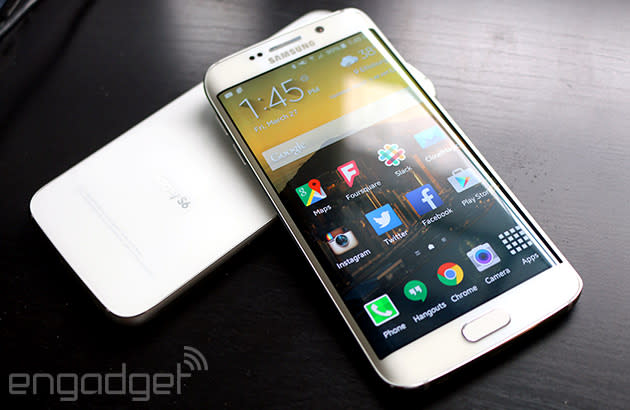
Alas, though, streamlining the S6's design meant taking an axe to some of the things that endeared the Galaxy line to persnickety nerds -- namely, the removable battery and microSD card slot. My T-Mobile review unit came with 32GB of internal storage ($0 down with monthly payments on T-Mo, or $199 with a contract elsewhere), but you'll soon be able to buy 64GB and 128GB models too. And the biggest heartbreak? The S6 breaks tradition by dying when you drop it in a pool. The news will be more tragic for some than others but not having to handle the S5 with kid gloves was a treat. Hopefully Samsung figures out a way to waterproof a design like this before next year rolls around.
Now, about the Edge ($299 with a contract). It's equal parts gorgeous and gimmicky, but if money is no object, the former definitely outweighs the latter. Unlike the G Flex2, the Edge's curved screen falls away from you at the sides instead of angling toward you from the top and bottom. The design does nothing to make the screen more immersive, but that doesn't matter; the screen's novelty and beauty still mean it's hard to tear your eyes off it. The S6 Edge feels substantially thinner than its basic cousin because of how its sides taper to a super-slim edge. This trick is a familiar one -- Motorola has done it with every Moto X to date -- but it keeps getting recycled for a reason. The thing is, the Edge will probably never nestle comfortably into your hands as a result; if your fingers are like mine, they'll forever arch over its back, which can sometimes feel a little precarious. In fact, at times I wished the curve were on the opposite side just so the rest of my hand had something to hang onto. On the plus side, that extra space along the Edge's sides gives you room to swipe up, down, left and right without your thumb ever obscuring the action. Really, though, these navigational benefits feel like an afterthought, like happy little accidents that came about thanks to Samsung's screen-shape decision. Make no mistake: The Edge's main job is to look good.
Display and sound
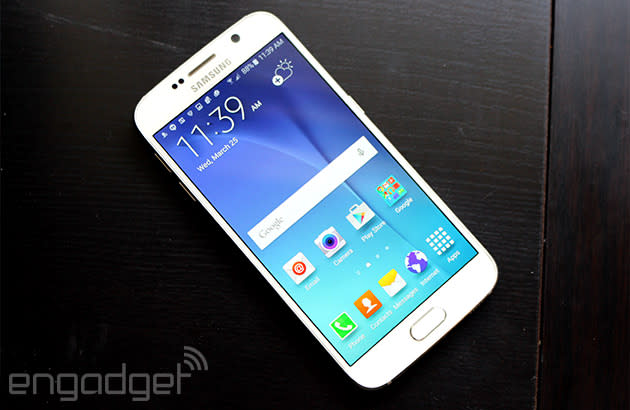
If you wanted to skip this section outright, just know this before you go: The S6 and the S6 Edge have absolutely gorgeous screens. They're both Quad HD panels (2,560 x 1,440, if you haven't memorized it yet) akin to the one you'll find in the Note 4, but they only measure at 5.1 inches diagonally. Yep, you guessed it: That means we're looking at two of the most pixel-dense screens on the market today. As far as your eyes will be able to tell, individual pixels don't even exist. Whether or not modern smartphone screens actually need to be this insanely crisp is a question that's up for debate, but my stance is pretty simple: As long as battery life doesn't tank as a result, bring 'em on.
As is usually the case with Samsung's AMOLEDs, colors are incredibly vivid, while blacks are deep and sumptuous. A quick bit of screen nerdery for you: AMOLED panels typically skew a little more toward the blue end of the spectrum than LCDs do, which means it's actually a pleasant surprise that whites appear more neutral here than they do on the new HTC One M9. Some of this is going to be subjective, of course. I'll admit I like my screens a little punchy, and the S6's color settings suited me just fine out of the box. If that's not your taste, you can pop into the settings and swap screen modes to something more appropriate: the "AMOLED cinema" setting pumps up color saturation across the board, while "AMOLED photo" dials it down a bit from the default "Adaptive" setting. Then you've got the "Basic" setting, which just sucks the life out of everything. It's arguably the most accurate mode of the four, but really, where's the fun in that? Viewing angles on the S6 are great too -- a lucky break for the poor soul whose in-flight entertainment system crapped out and has to watch your episodes of The Fall from the side.
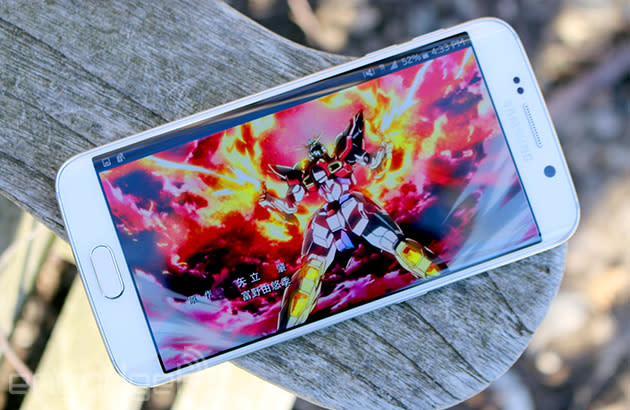
So far I've been treating both screens as if they were the same, but that's clearly not true. The Note Edge wanted to cram gobs of functionality into that spillover area. The G Flex and G Flex2 sought to draw you into media with a curved screen reminiscent of high-end TVs. The S6 Edge does none of those things. It just sort of... is. I'll break down more what the screen's edges actually can do down in the software section, but Samsung's overriding concern here was making a screen that looks awesome, and on that front, it succeeded. At its most severe, the Edge's screen curves away from you at about 35 degrees, as if the sides are retreating into your palms. Let's put our nitpicker hats on for a second -- that means that from some oblique angles, the stuff that flows into those subtle curves will appear much brighter than it does on the flat part of the screen. It's the mildest of annoyances (I don't remember ever being bothered by it), but it'll definitely stand out at first.
So yes, the S6 and the S6 Edge look lovely. How do they sound? Both devices share the same single speaker nestled into the bottom-right corners of their frames, and it's dramatically louder than the clunker we got in last year's Galaxy S5. There's no way it'll ever hold a candle to the One M9 and its pair of BoomSound speakers, but the S6 duo's driver brings enough oomph to the table that you can stick the phone into your car's cupholder, crank up the volume and still hear plenty over the din of the road.
Software

Like every other phone maker worth its salt, Samsung has spent the past year or two slowly cranking down on the sheer amount of stuff it slops on top of stock Android. It really shows, too: The version of TouchWiz that ships on the S6 and the S6 Edge is about as restrained as I've seen on a Samsung phone yet. Turns out, chopping out extraneous menu options and visual cruft was high up on the company's list of priorities this year, so don't ever let anyone tell you that complaining ad nauseam can't get huge conglomerates to rethink their plans.
Anyway, all of Samsung's greatest hits are still here, and they're paired with a flatter, cleaner, Material Design-y look that jibes nicely with Android 5.0.2. Seriously, it's terribly refreshing if you're coming from a Galaxy S5. Swiping to the left once again reveals your Flipboard Briefing, a BlinkFeed-like stream of news stories culled from news sources around the web. It might not pull choice updates from your Twitter or Instagram accounts like on an HTC phone, but it does look a hell of a lot handsomer. The app launcher itself is a little less attractive, at least at first. By default, Samsung has arranged all of its apps (including Microsoft pack-ins like OneNote and OneDrive) and everything else you install gets tacked on the end of the list in the order you downloaded it. Thankfully, there's an "A-Z" button in the corner to whip things into more manageable shape. Oh, and you can resize the app grid on your home screen to accommodate up to 20 shortcuts, not including widgets.
Now, I was plenty (and surprisingly) fond of TouchWiz's style the moment I fired up these phones, but you can choose from about 12 different themes if you're itching for something else. Right now Samsung's Theme Store leans heavily toward the cutesy side with themes that feature super-simple, hand-drawn icon sets and artwork; the only deviation from the norm is a tie-in theme for The Avengers: Age of Ultron. Nothing like the smell of brand synergy, right? Anyway, moving on. A quick tap on the Recent Apps button brings up the usual deck of app cards, but you'll notice a Multi Window icon on some of them -- tapping that'll resize the app to take up half the screen, leaving enough room to either see the app running beneath it or resize another one to fill the other half completely. Works like a charm when you need it (I'll admit to simultaneously browsing Facebook and Instagram in my weakest moments), and it's so much less of a headache to activate now. Props, Samsung.
Oh, and while we're talking about apps, no, you cannot uninstall whatever you want by pressing, holding and tapping a delete icon. Trying it on an app you've downloaded works fine. Try it on a preloaded app (say, S Health) and you'll instead get a prompt to disable it; that is, you can shut it off, but you can't remove it from the phone. What about stuff you don't want to delete, but don't want anyone else seeing? Private mode is still around and ready to keep your media and files out of the wrong hands. What's more, the fingerprint sensor baked into the Home button is both better (just press your finger into it, no swipe required) and easier to set up.
S Health has gotten some improvements too, although most of them are in appearance only; health data like your steps taken and heart rate recordings appear in a grid that reminds me an awful lot of Withings' health app. It's easy to add or remove categories from the grid, and all the usual tricks, like measuring the amount of oxygen in your blood, are present and accounted for. Curiously, the UV-sensing feature that we spotted on the Note 4's version of the app is gone here, but hey, I hardly ever used it other than to prove to others I could. Also missing is perhaps the most interesting trick Samsung has up its sleeve: Samsung Pay. Both the S6 and S6 Edge can technically transmit payments with the traditional mag-stripe readers found in most retail stores, but those chops will go untested until the app that ties everything together launches later this year.
Using the Edge

This is where you might expect the Edge to shine. After all, the test balloon that was the Note Edge used that extra space extensively, right? Well, not exactly. I'd argue the big Edge tried to shoehorn as many little gimmicks as it could into that little side-screen (does anyone really need a ruler on their phones?), and it seems like Samsung over-corrected here. A brief aside: None of the little applets created with the Note Edge's SDK are usable here, so don't even bother.
Swiping in from the upper left or right part of the screen (you'll indicate during setup if you're a righty or lefty) causes an array of colored bubbles to drift into view. That's People Edge. You can assign up to five people their own specific color, so that when they contact you, the edge of the phone will spring to life with their assigned hue. It's a neat trick, for sure, but its value is limited. To start, why the limit on five people and colors? And if the edge that lights up happens to be pointing away from you, you might as well just flip the phone over and see who it is instead of turning it around to see what color is throbbing.
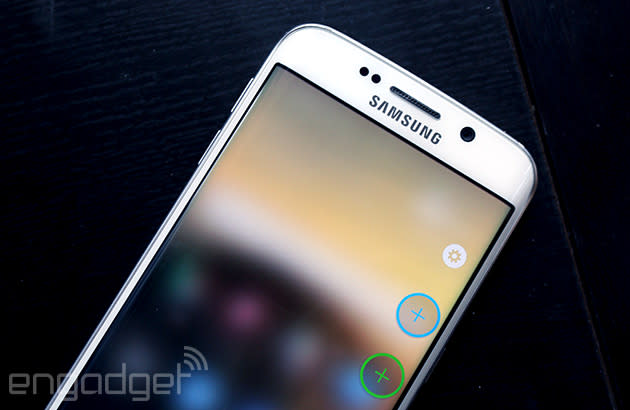
Meanwhile, rubbing the edge of the screen while it's off causes Samsung's so-called Information Stream to pop up, giving you access to the time, notifications and news updates without lighting up the whole panel. Truly, it's so much more convenient to tap the Home button to see all that than to stroke the edge of a screen; in fact, it's so much easier that to even bother just seems silly. It'd be another story if the news headline that showed up was somehow tied to your preferences as set in Flipboard Briefing, but nope -- it's just some random nothing from Yahoo News. Oh, and you can turn on a clock that'll live on the edge until the battery level drops below 15 percent. That's the only truly useful feature in the mix... except it only works for 12 hours at a time. What? The thing is, I appreciate that Samsung didn't try to bog the Edge down with nonsense, but in doing so, it proved it still doesn't know what to do with that extra space. That'd be a greater sin if the screen didn't look so damned cool, but none of this helps sell the Edge to anyone who's on the fence.
Camera

The cameras in Samsung's high-end phones have always been at least above average, but that's not good enough anymore. Nailing the camera was just crucial this time around and, long story short, Samsung did a great job. But first, the broad strokes. The S6 and the Edge share the same 16-megapixel rear camera (made by Sony, no less), which doesn't sound incredibly impressive compared to some of the other sensors used in other phones. Still, the combination of the sensor plus optical image stabilization and an f/1.9 lens is highly effective; nearly all the photos I've shot are appropriately colorful, crisp and finely detailed.
Performance in low light is mostly great too, though you'll occasionally have to tap to focus a few times to make sure you're actually homing in on what you wanted. HDR mode can help tremendously here when photons are scarce, but it's best used when you're photographing dim landscapes or subjects that can sit still. The fact that we've got a beautiful Quad-HD AMOLED screen to view them on is a huge plus too (though your screen color settings might mean the actual photo looks different on your phone than on a computer or television). Meanwhile, the wide-angle lens on the 5-megapixel front-facing camera makes for some seriously spacious selfies -- it captures way more of your surroundings than you might expect, so bring the phone in close for the best results. Just be sure to dial down Beauty Mode to keep your face from looking like you got plastered with foundation. That's not to say the camera experience is perfect; the auto-exposure can be a little finicky sometimes, leading to some overly warm shots when things get dim.
When it comes to the competition, the S6 and Edge produce photos that were better exposed and more vivid than the ones I shot using the HTC One M9. I don't mean for this to turn into a Samsung/Apple slapfest, but the iPhone 6 and 6 Plus have always been my go-to mobile camera because they capture almost uniformly lovely shots with virtually no effort at all. That's always seemed like something Android devices have had trouble with and I'm happy to report the S6 and S6 Edge are -- finally -- definite exceptions to the rule. All the photos you'll see in the gallery above were shot with everything set to auto and with HDR off, and I've dumped them into this Flickr album in case you want to take a closer look.

For the sake of speed, you can fire up the camera by swiping up on the home screen or by double-tapping the Home button at any time. Samsung says it only takes 0.7 second to jump into the camera proper, and while I haven't been sitting around with a stopwatch checking the claim, I've always been able to start snapping new shots in about one second. By default, the Samsung camera app is straightforward; the shutter button and mode selector live on one end, and a quick tap reveals controls for your flash, timer and HDR on the other. If you're anything like me, you'll be working with this default configuration most of the time and the results won't leave you complaining. You can, however, jump into a Pro mode where you can fiddle with your exposure, ISO and metering settings, and it's easy enough to save those changes as a preset to be fired up later.
Pro mode aside, you've got your usual slew of kooky features to play with, but the new ones are worth pointing out. Kicking the camera into background defocus mode is a nifty little attraction that lets you selectively blur parts of your shots, sort of like a Lytro, but all in software. Thing is, you can often coax that sort of bokeh from the lens and camera without software trickery at all so long as you stick the phone close to your subject. There's a Virtual shot mode that captures a 3D video of an object if you can move around it smoothly enough too, and it's cool enough until you realize you can't share it and still maintain the flashy effect. The ability to record 4K video is back as well, and with the same five-minute limitation Samsung aficionados will already be familiar with. Most of the video I shot between the two devices was on par with the still photos I took, and a new object-tracking autofocus (a feature I'm used to seeing more in DSLRs) usually works like a charm too. At the end of the day, I'd still give the photographic edge to the iPhones, but it's an awfully tight race and Android fans can buy an S6 or S6 Edge without fear of working at a disadvantage.
Performance and battery life
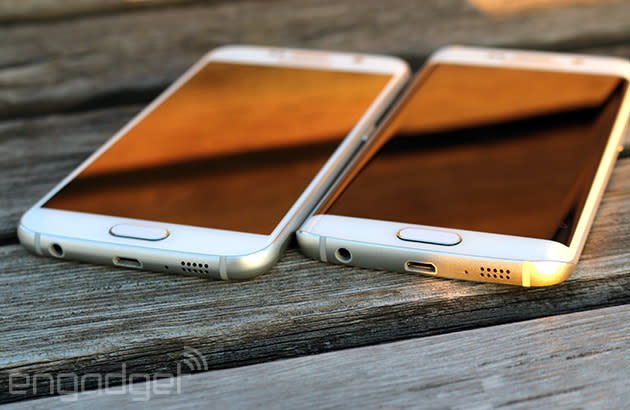
With each passing year we demand more and more from our tiny pocket-computers, especially when they're hyped up the way flagships are. The hype was especially boisterous this year: A crush of reports maintained that Samsung was originally on the Snapdragon train, before it ditched the 810 in favor of silicon of its own making. The end result: Top-tier devices from HTC and LG stuck with the 810 while the S6 and the S6 Edge sport a homebrew octa-core Exynos 7420 chipset, which pairs a quartet of 2.1GHz processor cores with another quartet of 1.5GHz cores and 3GB of RAM. When it comes to regular, day-to-day performance, the differences are slight. That's to be expected, really; we're inching toward an age so profuse with processing power, so rife with RAM that flicking through home screens and firing up apps on flagship phones is nearly seamless. Both the S6 and the Edge were incredibly snappy, with virtually zero lag during normal use. I could usually coax the phones to take a little longer than normal to figure out what to do next, but the keyword there is "coax" -- we're talking opening apps and leaping between them faster than anyone would ever need to just to be an ass. Whenever I used the phone as I normally would, both devices were basically butter.
Speaking of butter, it wouldn't surprise me if devices running the Snapdragon 810 occasionally ran warm enough to melt some. That was supposedly the reason Samsung ditched the chipset altogether, and if true, the folks in Korea made the right call. Graphics- and processor-intensive tasks usually push smartphones to their limits, so I spent about 45 minutes sifting through the auto-firing tedium that is Dead Trigger 2. The S6 and Edge scarcely warmed up at all. Ditto for the hours I spent drifting around Asphalt 8 with the visual quality cranked all the way up. The phones got a touch warmer while I was running some benchmark tests, but the heat buildup was nowhere near as noticeable as it was on the M9.
Samsung Galaxy S6/Edge | HTC One M9 | Samsung Galaxy Note Edge | iPhone 6 Plus | |
|---|---|---|---|---|
AndEBench Pro | 10,552 | 7,404 | 8,886 | N/A |
Vellamo 3.0 | 3,677 | 2,874 | 1,882 | N/A |
3DMark IS Unlimited | 21,632 | 21,409 | 19,912 | 17,902 |
SunSpider 1.0.2 (ms) | 674 | 706 | 788 | 388 |
GFXBench 3.0 1080p Manhattan Offscreen (fps) | 25 | 22 | 18.4 | 18.2 |
CF-Bench | 62,257 | 53,579 | 40,143 | N/A |
SunSpider 1.0.2: Android devices tested in Chrome; lower scores are better. | ||||
That the S6 and Edge would be super-snappy was sort of a given, but the bigger question is how long they'll last before they need a trip to the power outlet. Before we tackle that, it's worth noting that the two S6s aren't identical in this regard: The basic S6 has a 2,550mAh battery while the Edge has a slightly bigger 2,600mAh one. Oh, and don't forget that both batteries are sealed too; the age of swapping spare cells into your new Galaxy S is finally over, I'm afraid. Samsung says its new line of 14nm Exynos processors are designed to deliver more horsepower at greater efficiency, which leads to both versions of the phone sticking around for between 11 and 12 hours of continuous workday use (which in my case consists of horsing around on social networks, firing off emails in CloudMagic, taking a smattering of calls and the occasional prolonged bathroom break playing games).
That's not shabby, but it does lag slightly behind the 13 hours I regularly squeezed out of the One M9 and my old Galaxy S5. Neither device really dazzled in our standard Engadget rundown test, either. With a 720p video set to loop with the cellular and WiFi radios on and the screen brightness set to 50 percent, the S6 only lasted eight hours and 49 minutes. Meanwhile, the Edge and its very slightly bigger battery hung in there for nine hours and two minutes before finally giving up the ghost. In case you're wondering, both died about an hour before last year's Galaxy S5 did, although they beat out the HTC One M9 by about 40 minutes. Thankfully, all of this is offset a bit by the fact that both devices recharge quickly; think: bone-dry to 50 percent in 30 minutes.
The competition
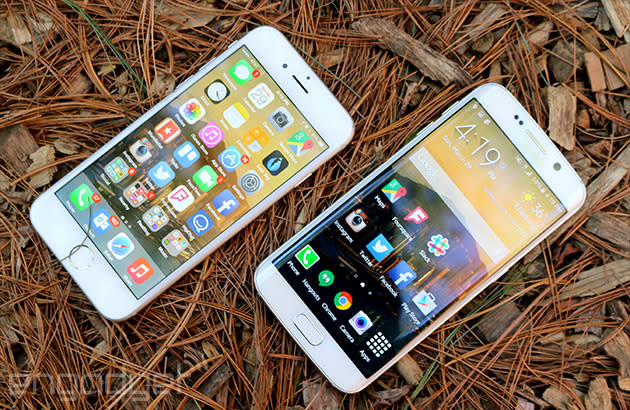
This is shaping up to be an awesome time to buy a smartphone, as some of the biggest players have already revealed their flagships for the year. First up: the HTC One M9. It made its US debut at nearly the same time as the S6 and the S6 Edge, and with it comes a very familiar set of design genes, Qualcomm's shiny new Snapdragon 810 chipset and a mostly great set of speakers. If anything, its tragic flaw is the 20-megapixel camera sitting high on its back. During my weeks of testing, I couldn't reliably get photos that were better than what last year's M8 was capable of. Honestly, the average consumer probably won't be able to tell, but the issue is made doubly troubling by the fact that the S6 duo's cameras are among the best I've ever seen in a smartphone. If you're not one of the diehards that love HTC's design DNA, this could be a tough choice (especially since the most basic versions of both devices start at $199 with a contract).
LG's G Flex2 ($199 on contract) also rocks a Snapdragon 810 chip, and is currently the fastest thing Samsung's Korean rival has on offer... for now. While the left and right of the S6 Edge's screen curve away from you, the Flex2's top and bottom curve toward you -- the idea is your media will suck you in when you turn the thing on its side. Does it work? Not as much as I'd like. Alas, LG's usually light touches with its Android overlays were just weighty enough to slow down day-to-day usage. Meanwhile, Samsung has dialed down TouchWiz's odiousness to the point where I prefer it over LG's interface anyway. And pardon me for getting a little meta, but the S6 Edge's biggest competitor is none other than the regular S6. Both phones are absolutely identical where it matters, and the Edge's subtly curving screen is pure gimmick; none of the Edge's software tricks come close to justifying a $100 price difference on contract. Unless you absolutely love (and I mean love) the curved look, you can safely buy an S6 and know that you're not missing out on anything of crucial importance.
Then, of course, there's the iPhone. Say what you will about Samsung taking design cues from Cupertino -- if you're not sure whether to go iOS or Android, your decision just got a lot tougher. Apple's ecosystem usually gets buzzy new apps before Android does, and I'd say the cameras on the iPhone 6 and 6 Plus (more the latter, really) are just a hair better. Still, the combination of some top-notch hardware and a version of TouchWiz that's mostly a pleasure to use means I'm considering dropping my iPhone 6 in favor of an S6 Edge as my full-time daily driver. Now, if only my friends would all use something other than iMessage.
Wrap-up

I've never been a huge fan of Samsung phones. For years, the software felt too kludgy, the designs chintzy and scattershot. Not so this time. Samsung has in the S6 a flagship that feels well thought-out and complete in a way I wasn't sure the company was capable of anymore. Calling it "perfect" would be irresponsible and inaccurate, but the S6 is the closest Samsung has come in a long time.
Then there's the Edge. If it hasn't become abundantly clear already, let me belabor the point one last time: There is no functional benefit to owning this thing. It does everything the regular S6 does, and what few edge-friendly tricks it packs aren't even all that useful. The only real reason to buy it is because you like the way it looks -- and I do. I really, really do. Together, they're the brightest stars in Samsung's galaxy, and the S6 in particular will rightfully wind up in a lot of people's pockets. If you've got cash to burn, though, or if you're a real sucker for the new and beautiful, the S6 Edge might just be what you've been searching for.
















































































































































































